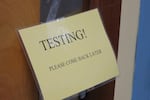
A sign on a computer lab at Portland's Abernethy Elementary School tells students and staff to stay out, while state testing takes place.
Rob Manning / OPB
Student performance on mandatory standardized tests in the spring of 2017 showed little change compared with results from the last two years, according to results the Oregon Department of Education released Thursday.
Oregon students — like students across the country — are required to take standardized tests every year, from third through eighth grade, and once in high school. But potential consequences for Oregon schools struggling to meet the tests' high standards are changing.
The latest results show less than half of all students in Oregon passed the math exams. The reading results slipped from 55 percent passing in 2016 to 53 percent last spring.
More: Read The Results From The Oregon Department of Education
It's been three years since Oregon switched over completely to the Smarter Balanced exams, tied to the Common Core State Standards. The exams are widely viewed as difficult and time-consuming. While critics have said they're confusing and have little value for students, many policymakers defend them as holding schools to lofty standards.
Huge disparities remain based on race. White students passed reading exams nearly 60 percent of the time. But just 31 percent of black students passed reading tests, and about 37 percent of Hispanic students.
The disparities were similar in math — though passing rates were lower across the board. White students passed math exams, on average less than 47 percent of the time. For black and Hispanic students, the passing rates were 18 percent and 24 percent respectively.
Oregon also had sizeable gaps based on income. Economically disadvantaged students passed math exams just 28 percent of the time, and reading about 41 percent of the time.
Those differences based on race and income are virtually unchanged over the last three years of Oregon students taking the Smarter Balanced exams.
Schools with the most students passing generally fell into two categories. There were schools serving predominantly affluent families like Ainsworth Elementary in Portland's west hills and Riverdale Grade School near the Portland-Lake Oswego border, where more than 90 percent of students passed reading and over 80 percent passed math. Smaller, rural schools sometimes stood out, too, like the high passing rates on the reading test at high schools in Camas Valley (93 percent passing) and Oakland (93 percent) in Douglas County, and Pacific High in Port Orford (94 percent).
Standardized tests remain divisive and controversial among parents and students in parts of Oregon. Two years after legislators broadened the grounds for avoiding the exams, Oregon's already low participation rates slid further last spring, dropping below the federal minimum of 95 percent. At dozens of schools less than half of eligible students took the required exams.
Standardized testing in Oregon is likely to look different in the years to come, especially at the high school level. Oregon's federally required plan to improve schools anticipates phasing out the Smarter Balanced exam in high school and replacing it with a nationally-recognized exam like the ACT or SAT, which many Oregon high schoolers already take.
The consequences of schools performing poorly on state tests are also evolving.
No Child Left Behind threatened sanctions when schools receiving federal funding for low-income students fell short of standardized testing benchmarks. Under those rules, schools could be required to spend funds on tutoring or to transport students to better-performing schools. Schools could be required to restructure, as happened with several schools in Portland over a decade ago.
Oregon began moving away from those punitive measures in 2012, when the Obama Administration granted the state a waiver from many of NCLB's mandates. The changes under the state's Every Student Succeeds Act plan moved away from federal sanctions, giving more power to states. So, Oregon's plan focuses on giving targeted support to schools that fall short of specific goals, which range from limiting chronic absenteeism to getting freshmen to earn at least one quarter of the credits they need to graduate.
When it comes to measuring a school's academic performance and growth, the newly approved plan still relies on standardized test results, like those released Thursday by the Oregon Department of Education.
